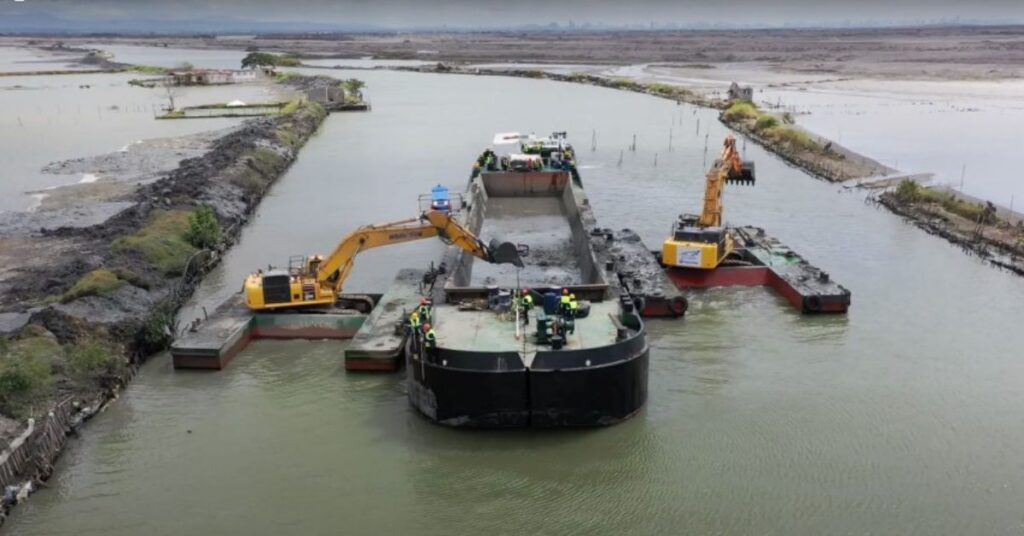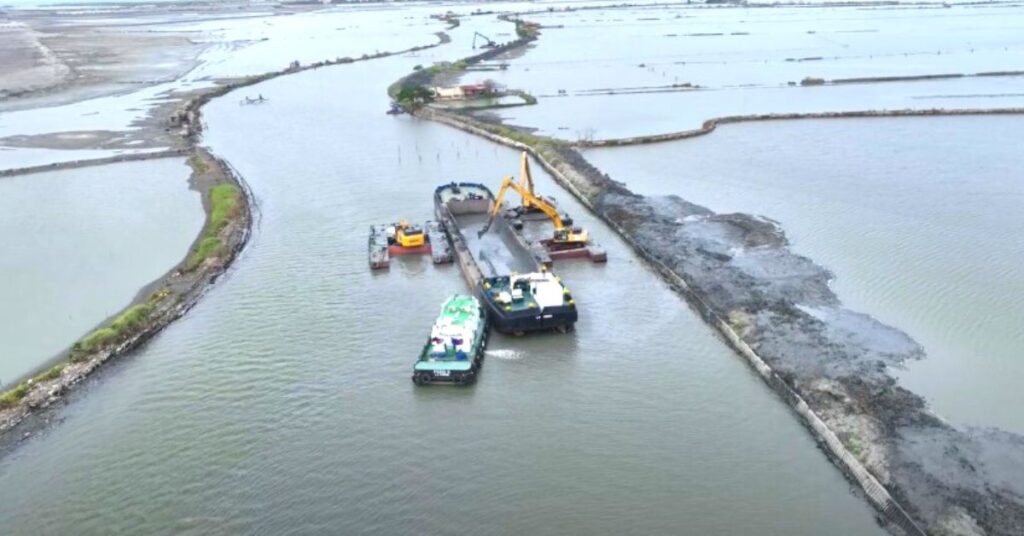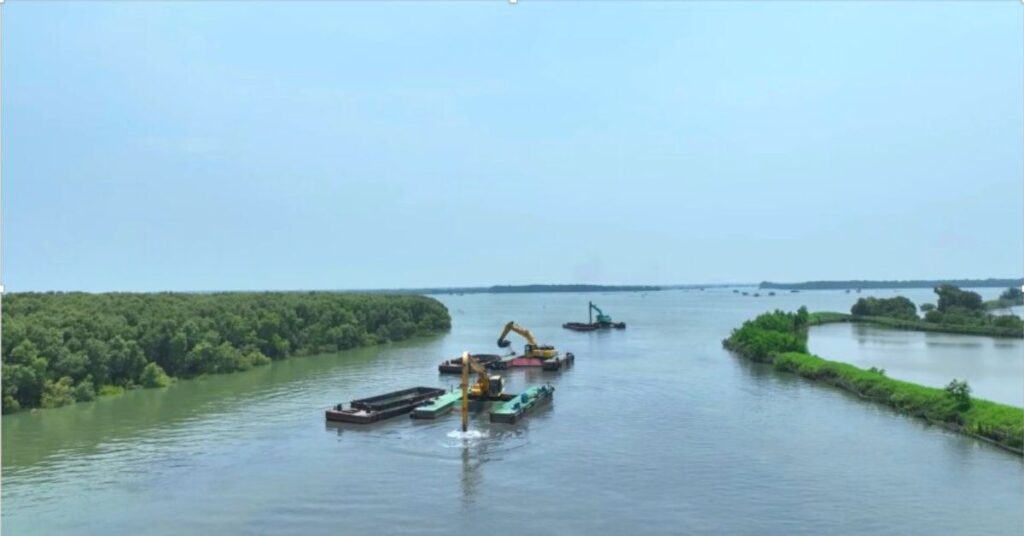Table of Contents
Less than four months after completing its P2-billion initiative to clean up the Pasig River, San Miguel Corporation’s (SMC) comprehensive efforts to rehabilitate significant river systems have shifted to high gear in Central Luzon.
In a little over a year, the company has removed more than 2 million MT of silt and waste covering a distance of around 25 kilometers of river channels in Bulacan, initially focusing on areas around the future New Manila International Airport and upstream rivers in Obando, Bulakan, Bocaue, and Meycauayan City within the same catch basin.
SMC conducting bathymetric studies

Additionally, SMC has started conducting bathymetric studies at the Pampanga River, following the completion of river studies in another catch basin in Bulacan.
Bathymetric studies involve the comprehensive measurement and mapping of underwater depths and the topography of ocean floors, lakebeds, or other aquatic bodies. These studies provide detailed insights into the submerged landscape, encompassing depths, contours, and features beneath the water’s surface.
Utilizing various techniques, bathymetric studies primarily focus on depth measurement. Sonar technology, in particular, is commonly employed in these studies. Bathymetric studies calculate accurate water depths by emitting sound waves into the water and measuring the time it takes for the waves to return. The resulting data is then used to create depth profiles and maps illustrating the underwater topography.
One of the critical applications of bathymetric studies is creating maps depicting submerged features. These features may include underwater mountains, valleys, canyons, and geological formations. Such maps are invaluable for understanding the structural composition of seabeds or lakebeds. Moreover, bathymetric data ensures safe navigation, especially in regions where water depths vary significantly. Nautical charts derived from bathymetric studies assist mariners in avoiding underwater obstacles and planning safe routes.
Beyond navigation and safety, bathymetric studies contribute significantly to environmental research. The data offers insights into underwater ecosystems, habitats, and geological processes. This information is critical for studying marine life and assessing the impact of human activities on aquatic environments.

Bathymetric studies also play a pivotal role in resource exploration by identifying potential locations for fisheries, oil and gas exploration, and mineral extraction. The economic potential of underwater areas can be assessed through a thorough understanding of bathymetric data.
Furthermore, bathymetric studies have implications for climate studies. By examining the bathymetry of oceans and seas, scientists gain insights into ocean circulation patterns and their role in climate regulation. This knowledge aids in modeling and predicting various climate-related phenomena.
In essence, bathymetric studies are a multidisciplinary tool with applications in marine science, oceanography, environmental science, and resource management. The wealth of data collected through these studies enhances our understanding of the Earth’s underwater landscapes and supports a wide range of practical applications.
These studies aim to assess the water depth across the river channels and determine the shallow areas that restrict water flow through both provinces before reaching Manila Bay. Heavy siltation and pollution in these rivers significantly contribute to Bulacan and Pampanga’s widespread flooding.

Ramon S. Ang, SMC President and CEO, said that although the rainy season is months away, their cleanup teams have started working to increase the water-carrying capacity of these rivers and mitigate flooding, especially in low-lying areas, during heavy rains.
Ang explained that siltation and pollution have made many rivers narrow, shallow, and incapable of handling large volumes of floodwater, leading to severe flooding in adjacent areas.
He added: “Similar to our efforts at the Pasig and Tullahan Rivers, we are removing years of solid waste and silt accumulation to increase the rivers’ depth and capacity. This will improve water flow and ensure safer conditions for water vessels.”
Last October 2023, SMC launched its expanded river cleanup program by signing a memorandum of agreement (MOA) with the Department of Environment and Natural Resources (DENR), the Department of Public Works and Highways (DPWH), and the local government units of several cities and provinces.
The expanded program will include:
- The upstream areas of the Meycauayan, Marilao, Bocaue, and Guiguinto.
- Other central river systems in different catch basins are Malolos, Hagonoy, and Calumpit.
- The Pampanga River, and rivers in Laguna, Cavite, Navotas, and San Juan.
“Since completing our Pasig and Tullahan river cleanups, communities and stakeholders have reported lesser incidence of heavy flooding in their areas. Floodwaters recede faster when there is still flooding,” Ang noted.
He added: “Our recent project to clean up the Tullahan and Pasig Rivers has given our people significant experience and expertise in such massive efforts. Combined with our robust fleet of heavy equipment that we’ve already invested in, we’re fully prepared and committed to undertaking this expanded cleanup to rid our rivers of pollution and mitigate flooding,” Ang said.
To date, SMC has removed a total of 2,017,336 metric tons of silt and waste, completing the surrounding rivers of the future site of the New Manila International airport in Maycapiz – Taliptip River, downstream part of Meycauayan River and moving upstream of Meycuayan River, Mailad- Sta Maria River and Guiguinto River.
Including the total output of its Pasig River cleanup, which includes the still-ongoing cleanup of the San Juan River (1,437,391 tons of silt and wastes) and the completed Tullahan River cleanup (1,124,183 metric tons), SMC’s river rehabilitation efforts have removed over 4.5 million tons of wastes from approximately 68 kilometers of river systems.
SMC is further extending its cleanup operations in Bulacan to include the Pamarawan River, Malolos River, Hagonoy River, Labangan-Angat River, and Pampanga River, extending up to the North Luzon Expressway (NLEX).
Read SMC, gov’t forge most extensive CSR collaboration to clean up, rehabilitate Luzon rivers 2023, SMC Commits to Thorough River Revitalization in Bulacan, Central Luzon, to Tackle Recurring Flooding Problem, and SMC completes Tullahan River cleanup, 1.12 million tons of waste removed in two years.